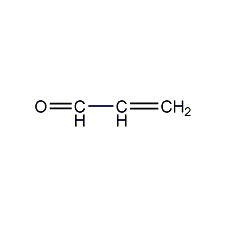
Structural formula
| Business number | 02UF |
|---|---|
| Molecular formula | C3H4O |
| Molecular weight | 56 |
| label |
2-Acrolein, septic aldehyde, antimicrobials, Acraldehyde, Acrylic aldehyde, 2-Propenal, Aqualin, herbicide, fungicides, aldehyde solvent |
Numbering system
CAS number:107-02-8
MDL number:MFCD00006998
EINECS number:203-453-4
RTECS number:AS1050000
BRN number:741856
PubChem number:24845183
Physical property data
1. Properties: colorless or light yellow liquid with foul odor. [1]
2. pH value: 6 (10% aqueous solution) [2]
3. Melting point (℃ ): -87.7[3]
4. Boiling point (℃): 52.5[4]
5. Relative density (Water=1): 0.84[5]
6. Relative vapor density (air=1): 1.94[6]
7. Saturated vapor pressure (kPa): 29.33 (20°C) [7]
8. Heat of combustion (kJ/mol): -1625.74[ 8]
9. Critical pressure (MPa): 5.06[9]
10. Octanol/water partition coefficient: -0.01 ~0.9[10]
11. Flash point (℃): -26 (CC) [11]
12 .Ignition temperature (℃): 234[12]
13. Explosion upper limit (%): 31.0[13]
14. Lower explosion limit (%): 2.8[14]
15. Solubility: soluble in water, easily soluble in most organic solvents such as ethanol and acetone. [15]
16. Viscosity (mPa·s, 20ºC): 0.35
17. Refractive index at room temperature (n25): 1.397424.5
18. Gas phase standard entropy (J·mol-1·K-1): 281.7
19. Liquid phase standard combustion heat (enthalpy) (kJ·mol-1): -1638.68
20. Liquid phase standard claimed heat ( Enthalpy) (kJ·mol-1): -113.51
21. Liquid phase standard hot melt (J·mol-1·K-1): 121.1
Toxicological data
1. Acute toxicity[16]
LD50: 26mg/kg (rat oral); 14mg/kg (mouse oral Oral); 7mg/kg (rabbit oral); 200mg/kg (rabbit transdermal)
LC50: 18mg/m3 (rat inhalation, 4h)
2. Irritation [17]
Rabbit transdermal: 5mg, severe irritation.
Rabbit eye: 1mg, severe irritation.
3. Subacute and chronic toxicity [18] The concentration of rats continuously exposed to this product is 4.8mg/m3 ,40h later, the alkaline phosphatase activity of his liver increased.
4. Mutagenicity [19] Human cell DNA damage: 30μmol/L. Human lymphocyte sister chromosome exchange: 5μmol/L.
5. Teratogenicity[20]&nbs�0.5: 0.026.

2. Industrial preparation method is currently mainly used in industry Catalytic air oxidation of propylene.
Mix propylene, air and water vapor in a certain proportion and send them to the fixed bed reactor together with the catalyst. The reaction is carried out at 0.1~0.2 MPa and 350~450°C. The contact time is 0.8 s. The heat released by the reaction is recovered. Used for steam production. The gas mixture generated by the reaction is quenched with water, and the tail gas from the quench tower is washed before venting. The organic liquid coming out from the bottom of the quenching tower enters the stripping tower to strip out acrolein and other light components, and then use distillation to remove water and acetaldehyde from the crude acrolein. Reaction formula:
Feeding ratio (mol) propylene: air: water vapor = 1:10:2.
![]()
3.Acrolein is produced by gas phase catalytic condensation of acetaldehyde and formaldehyde under the action of a catalyst. Or under the action of a catalyst, propylene is oxidized with air to produce acrolein. The by-products are acetic acid, acetaldehyde, acrylic acid and carbon dioxide.

Purpose
1. Mainly used to manufacture methionine and other acrolein derivatives, used as standard materials for chromatographic analysis, and also used in organic synthesis to separate zinc from cobalt, manganese, and nickel.
2. Fungicides. It is used as a bactericide in oil field water injection and industrial circulating cooling water treatment. It is not used as a slime preventer in the paper industry. The dosage used in oilfield reinjection water treatment is generally 10 to 15 mg/L. In neutral to slightly alkaline circulating water systems, the usual dosage is 0.2 to 1mg/L.
3. Used as a fungicide for oilfield water injection, it can promote the effective flow of water, inhibit the growth of bacteria in the water, eliminate the odor of hydrogen sulfide compounds in oilfield water, and prevent bacteria from causing corrosion and blockage in pipelines and strata. Used as a bactericide in industrial circulating cooling water treatment. Used as a slime preventer in the paper industry.
4 is one of the important raw materials in the synthetic resin industry and is also widely used in organic synthesis and drug synthesis. [31]


